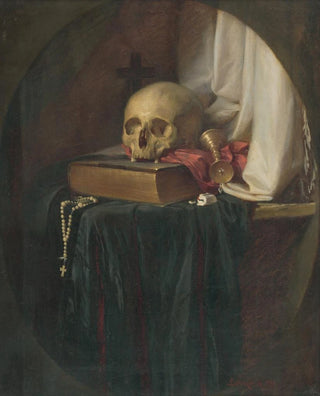Art print | Still life with a skull and a book - Gyula Benczúr


View from behind

Frame (optional)
Nature morte with a skull and a book - Gyula Benczúr – Captivating introduction
The art print of a skull with a book by Gyula Benczúr is a work that transcends the simple frame of painting to become a profound reflection on the human condition. This piece, emblematic of 19th-century academic art, invites us to contemplate the fragility of life and the permanence of knowledge. By juxtaposing symbolic elements such as a skull, representing mortality, and a book, symbol of knowledge, Benczúr encourages us to question our relationship with life, death, and wisdom. This artwork is not merely a pictorial representation; it is an invitation to meditate, to explore universal themes that traverse the history of art.
Style and uniqueness of the work
Benczúr's style is distinguished by its precision and attention to detail. Each element of the composition is carefully arranged to create a visual harmony that captivates the viewer. The use of shadows and lights accentuates the relief of the objects, giving the whole a striking depth. The skull, with its delicately rendered contours, almost seems to pulse under the light, while the open book evokes timeless wisdom. The color palette, subtly chosen, oscillates between dark tones and flashes of light, reinforcing the contrast between life and death. This duality, omnipresent in the work, reflects Benczúr's genius and his ability to transform simple elements into a complex reflection on existence.
The artist and his influence
Gyula Benczúr, master of Hungarian academicism, established himself as an essential figure of his time. Trained at the Vienna Academy of Fine Arts, he developed a style that combines tradition and innovation. His work reflects an era when art was meant to tell stories and convey emotions. Benczúr drew inspiration from the great masters of the past while infusing a personal touch into his creations. His meticulous approach and commitment to realistic representation allowed him to create works of great emotional intensity.

Matte finish

View from behind

Frame (optional)
Nature morte with a skull and a book - Gyula Benczúr – Captivating introduction
The art print of a skull with a book by Gyula Benczúr is a work that transcends the simple frame of painting to become a profound reflection on the human condition. This piece, emblematic of 19th-century academic art, invites us to contemplate the fragility of life and the permanence of knowledge. By juxtaposing symbolic elements such as a skull, representing mortality, and a book, symbol of knowledge, Benczúr encourages us to question our relationship with life, death, and wisdom. This artwork is not merely a pictorial representation; it is an invitation to meditate, to explore universal themes that traverse the history of art.
Style and uniqueness of the work
Benczúr's style is distinguished by its precision and attention to detail. Each element of the composition is carefully arranged to create a visual harmony that captivates the viewer. The use of shadows and lights accentuates the relief of the objects, giving the whole a striking depth. The skull, with its delicately rendered contours, almost seems to pulse under the light, while the open book evokes timeless wisdom. The color palette, subtly chosen, oscillates between dark tones and flashes of light, reinforcing the contrast between life and death. This duality, omnipresent in the work, reflects Benczúr's genius and his ability to transform simple elements into a complex reflection on existence.
The artist and his influence
Gyula Benczúr, master of Hungarian academicism, established himself as an essential figure of his time. Trained at the Vienna Academy of Fine Arts, he developed a style that combines tradition and innovation. His work reflects an era when art was meant to tell stories and convey emotions. Benczúr drew inspiration from the great masters of the past while infusing a personal touch into his creations. His meticulous approach and commitment to realistic representation allowed him to create works of great emotional intensity.






